Report on Humanitarian Practices in Emergency and Disaster Management
VerifiedAdded on 2020/10/22
|8
|2091
|57
Report
AI Summary
This report delves into the core concepts of emergency and disaster management, focusing on humanitarian practices. It begins by defining the field and exploring the application of humanitarian practices by organizations. The report contrasts two main approaches: Classical Humanitarianism, which emphasizes principles of humanity, neutrality, and impartiality, and the Transformative Agenda, which incorporates leadership, coordination, and accountability. A case study illustrates the application of both approaches in a flood scenario, allowing for a comparison of their merits and demerits. The report argues that the Transformative Agenda is more effective due to its emphasis on teamwork, collective response, and accountability, ultimately aiming to improve organizational responses and outcomes in crisis situations, backed by references for further reading. This report, contributed by a student, is available on Desklib, a platform offering AI-powered study tools.
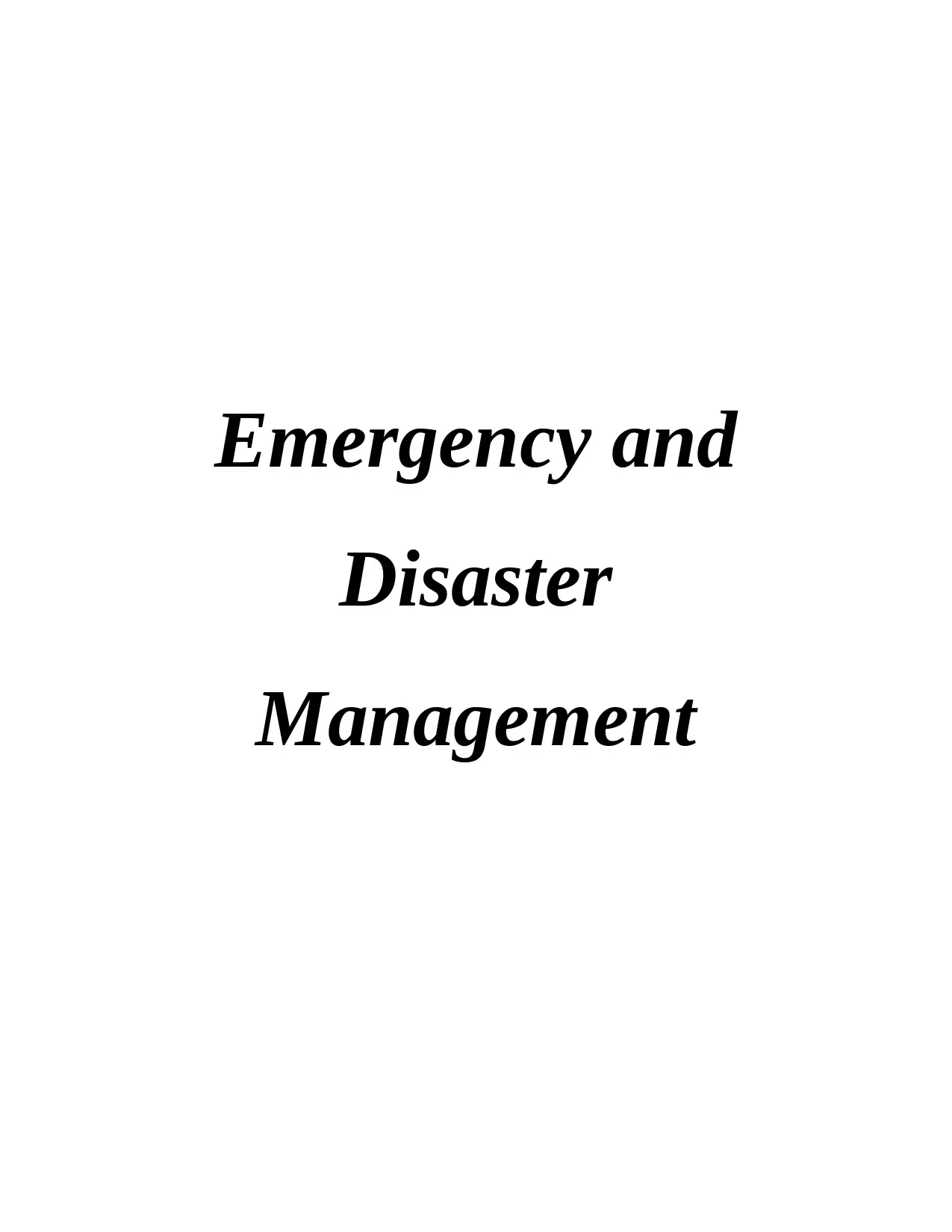
Emergency and
Disaster
Management
Disaster
Management
Paraphrase This Document
Need a fresh take? Get an instant paraphrase of this document with our AI Paraphraser
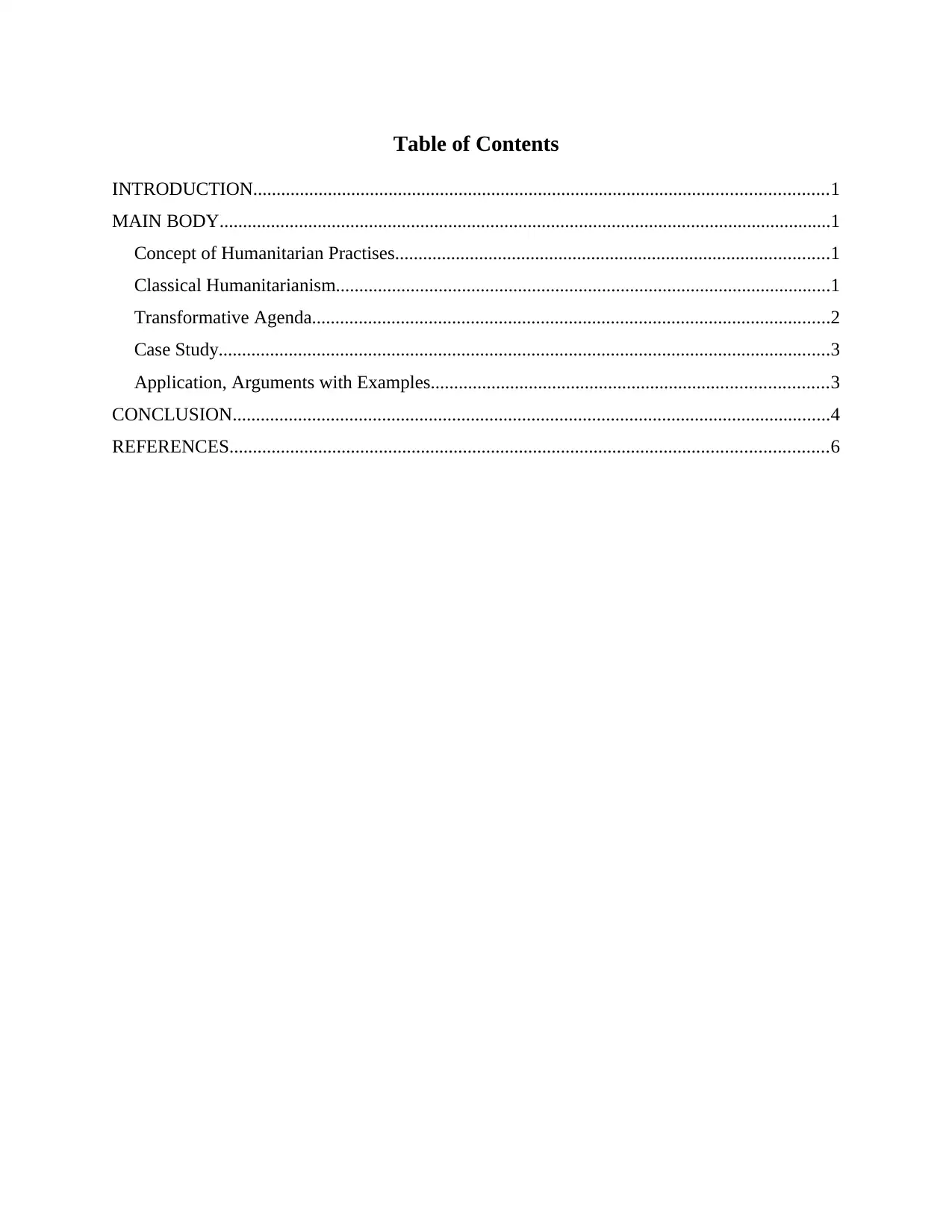
Table of Contents
INTRODUCTION...........................................................................................................................1
MAIN BODY...................................................................................................................................1
Concept of Humanitarian Practises.............................................................................................1
Classical Humanitarianism..........................................................................................................1
Transformative Agenda...............................................................................................................2
Case Study...................................................................................................................................3
Application, Arguments with Examples.....................................................................................3
CONCLUSION................................................................................................................................4
REFERENCES................................................................................................................................6
INTRODUCTION...........................................................................................................................1
MAIN BODY...................................................................................................................................1
Concept of Humanitarian Practises.............................................................................................1
Classical Humanitarianism..........................................................................................................1
Transformative Agenda...............................................................................................................2
Case Study...................................................................................................................................3
Application, Arguments with Examples.....................................................................................3
CONCLUSION................................................................................................................................4
REFERENCES................................................................................................................................6
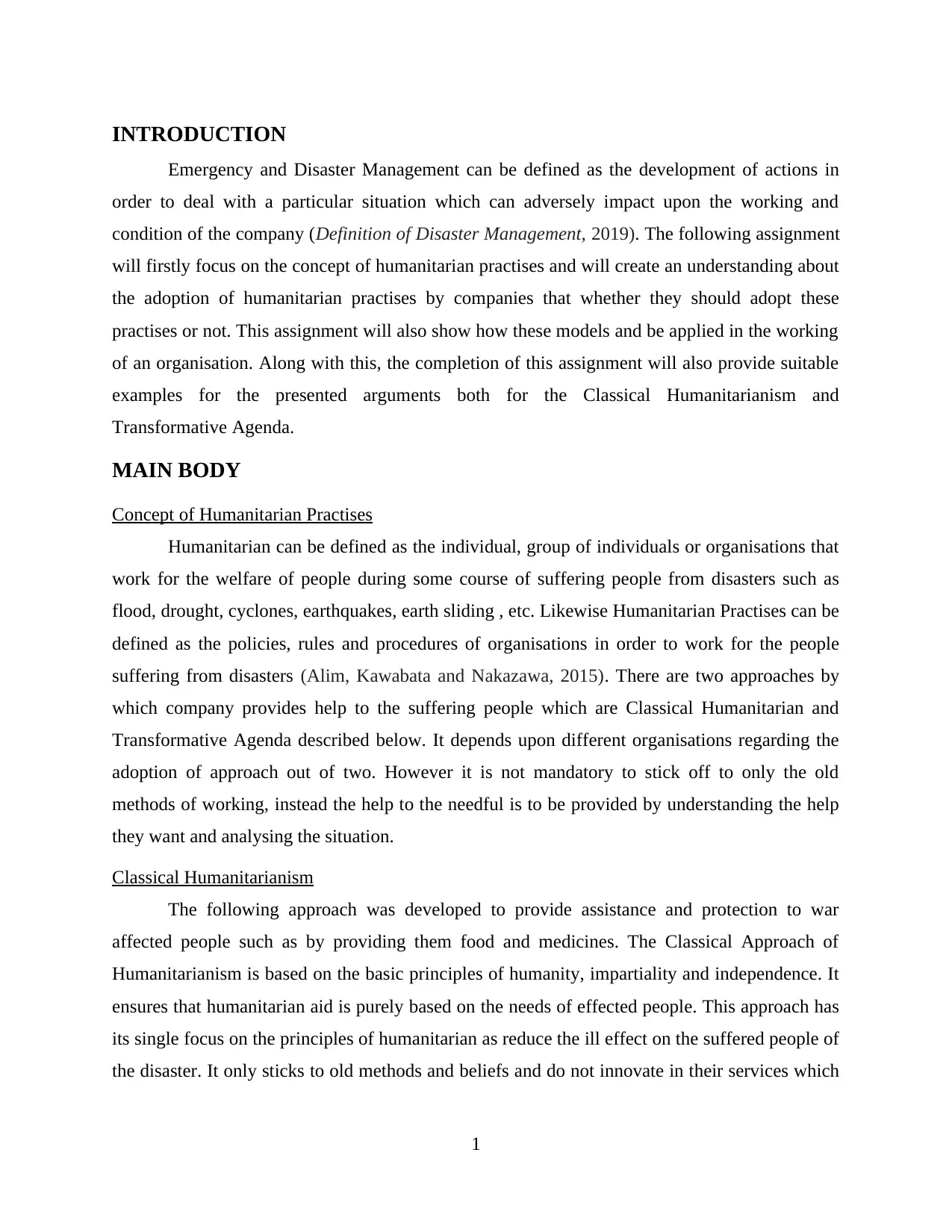
INTRODUCTION
Emergency and Disaster Management can be defined as the development of actions in
order to deal with a particular situation which can adversely impact upon the working and
condition of the company (Definition of Disaster Management, 2019). The following assignment
will firstly focus on the concept of humanitarian practises and will create an understanding about
the adoption of humanitarian practises by companies that whether they should adopt these
practises or not. This assignment will also show how these models and be applied in the working
of an organisation. Along with this, the completion of this assignment will also provide suitable
examples for the presented arguments both for the Classical Humanitarianism and
Transformative Agenda.
MAIN BODY
Concept of Humanitarian Practises
Humanitarian can be defined as the individual, group of individuals or organisations that
work for the welfare of people during some course of suffering people from disasters such as
flood, drought, cyclones, earthquakes, earth sliding , etc. Likewise Humanitarian Practises can be
defined as the policies, rules and procedures of organisations in order to work for the people
suffering from disasters (Alim, Kawabata and Nakazawa, 2015). There are two approaches by
which company provides help to the suffering people which are Classical Humanitarian and
Transformative Agenda described below. It depends upon different organisations regarding the
adoption of approach out of two. However it is not mandatory to stick off to only the old
methods of working, instead the help to the needful is to be provided by understanding the help
they want and analysing the situation.
Classical Humanitarianism
The following approach was developed to provide assistance and protection to war
affected people such as by providing them food and medicines. The Classical Approach of
Humanitarianism is based on the basic principles of humanity, impartiality and independence. It
ensures that humanitarian aid is purely based on the needs of effected people. This approach has
its single focus on the principles of humanitarian as reduce the ill effect on the suffered people of
the disaster. It only sticks to old methods and beliefs and do not innovate in their services which
1
Emergency and Disaster Management can be defined as the development of actions in
order to deal with a particular situation which can adversely impact upon the working and
condition of the company (Definition of Disaster Management, 2019). The following assignment
will firstly focus on the concept of humanitarian practises and will create an understanding about
the adoption of humanitarian practises by companies that whether they should adopt these
practises or not. This assignment will also show how these models and be applied in the working
of an organisation. Along with this, the completion of this assignment will also provide suitable
examples for the presented arguments both for the Classical Humanitarianism and
Transformative Agenda.
MAIN BODY
Concept of Humanitarian Practises
Humanitarian can be defined as the individual, group of individuals or organisations that
work for the welfare of people during some course of suffering people from disasters such as
flood, drought, cyclones, earthquakes, earth sliding , etc. Likewise Humanitarian Practises can be
defined as the policies, rules and procedures of organisations in order to work for the people
suffering from disasters (Alim, Kawabata and Nakazawa, 2015). There are two approaches by
which company provides help to the suffering people which are Classical Humanitarian and
Transformative Agenda described below. It depends upon different organisations regarding the
adoption of approach out of two. However it is not mandatory to stick off to only the old
methods of working, instead the help to the needful is to be provided by understanding the help
they want and analysing the situation.
Classical Humanitarianism
The following approach was developed to provide assistance and protection to war
affected people such as by providing them food and medicines. The Classical Approach of
Humanitarianism is based on the basic principles of humanity, impartiality and independence. It
ensures that humanitarian aid is purely based on the needs of effected people. This approach has
its single focus on the principles of humanitarian as reduce the ill effect on the suffered people of
the disaster. It only sticks to old methods and beliefs and do not innovate in their services which
1
⊘ This is a preview!⊘
Do you want full access?
Subscribe today to unlock all pages.

Trusted by 1+ million students worldwide
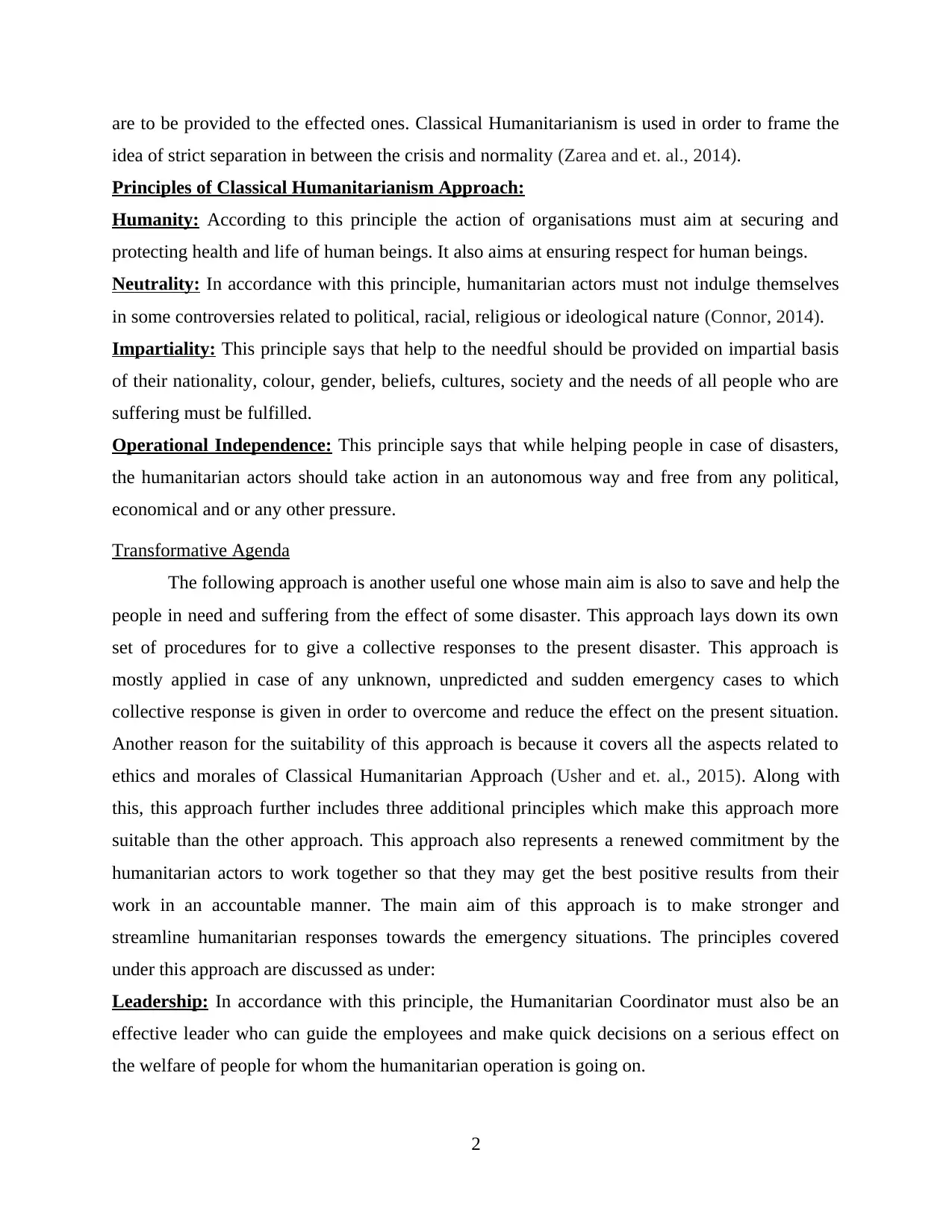
are to be provided to the effected ones. Classical Humanitarianism is used in order to frame the
idea of strict separation in between the crisis and normality (Zarea and et. al., 2014).
Principles of Classical Humanitarianism Approach:
Humanity: According to this principle the action of organisations must aim at securing and
protecting health and life of human beings. It also aims at ensuring respect for human beings.
Neutrality: In accordance with this principle, humanitarian actors must not indulge themselves
in some controversies related to political, racial, religious or ideological nature (Connor, 2014).
Impartiality: This principle says that help to the needful should be provided on impartial basis
of their nationality, colour, gender, beliefs, cultures, society and the needs of all people who are
suffering must be fulfilled.
Operational Independence: This principle says that while helping people in case of disasters,
the humanitarian actors should take action in an autonomous way and free from any political,
economical and or any other pressure.
Transformative Agenda
The following approach is another useful one whose main aim is also to save and help the
people in need and suffering from the effect of some disaster. This approach lays down its own
set of procedures for to give a collective responses to the present disaster. This approach is
mostly applied in case of any unknown, unpredicted and sudden emergency cases to which
collective response is given in order to overcome and reduce the effect on the present situation.
Another reason for the suitability of this approach is because it covers all the aspects related to
ethics and morales of Classical Humanitarian Approach (Usher and et. al., 2015). Along with
this, this approach further includes three additional principles which make this approach more
suitable than the other approach. This approach also represents a renewed commitment by the
humanitarian actors to work together so that they may get the best positive results from their
work in an accountable manner. The main aim of this approach is to make stronger and
streamline humanitarian responses towards the emergency situations. The principles covered
under this approach are discussed as under:
Leadership: In accordance with this principle, the Humanitarian Coordinator must also be an
effective leader who can guide the employees and make quick decisions on a serious effect on
the welfare of people for whom the humanitarian operation is going on.
2
idea of strict separation in between the crisis and normality (Zarea and et. al., 2014).
Principles of Classical Humanitarianism Approach:
Humanity: According to this principle the action of organisations must aim at securing and
protecting health and life of human beings. It also aims at ensuring respect for human beings.
Neutrality: In accordance with this principle, humanitarian actors must not indulge themselves
in some controversies related to political, racial, religious or ideological nature (Connor, 2014).
Impartiality: This principle says that help to the needful should be provided on impartial basis
of their nationality, colour, gender, beliefs, cultures, society and the needs of all people who are
suffering must be fulfilled.
Operational Independence: This principle says that while helping people in case of disasters,
the humanitarian actors should take action in an autonomous way and free from any political,
economical and or any other pressure.
Transformative Agenda
The following approach is another useful one whose main aim is also to save and help the
people in need and suffering from the effect of some disaster. This approach lays down its own
set of procedures for to give a collective responses to the present disaster. This approach is
mostly applied in case of any unknown, unpredicted and sudden emergency cases to which
collective response is given in order to overcome and reduce the effect on the present situation.
Another reason for the suitability of this approach is because it covers all the aspects related to
ethics and morales of Classical Humanitarian Approach (Usher and et. al., 2015). Along with
this, this approach further includes three additional principles which make this approach more
suitable than the other approach. This approach also represents a renewed commitment by the
humanitarian actors to work together so that they may get the best positive results from their
work in an accountable manner. The main aim of this approach is to make stronger and
streamline humanitarian responses towards the emergency situations. The principles covered
under this approach are discussed as under:
Leadership: In accordance with this principle, the Humanitarian Coordinator must also be an
effective leader who can guide the employees and make quick decisions on a serious effect on
the welfare of people for whom the humanitarian operation is going on.
2
Paraphrase This Document
Need a fresh take? Get an instant paraphrase of this document with our AI Paraphraser
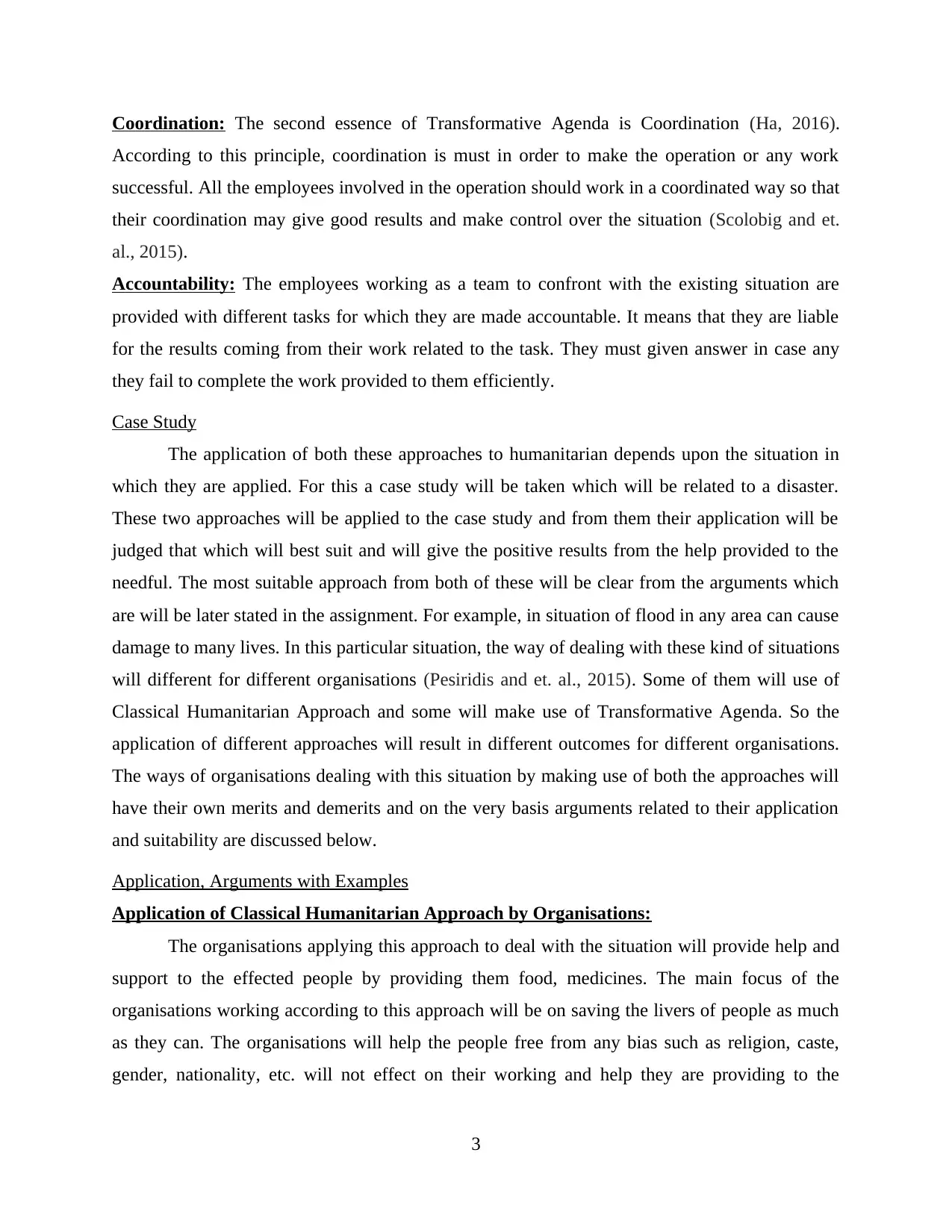
Coordination: The second essence of Transformative Agenda is Coordination (Ha, 2016).
According to this principle, coordination is must in order to make the operation or any work
successful. All the employees involved in the operation should work in a coordinated way so that
their coordination may give good results and make control over the situation (Scolobig and et.
al., 2015).
Accountability: The employees working as a team to confront with the existing situation are
provided with different tasks for which they are made accountable. It means that they are liable
for the results coming from their work related to the task. They must given answer in case any
they fail to complete the work provided to them efficiently.
Case Study
The application of both these approaches to humanitarian depends upon the situation in
which they are applied. For this a case study will be taken which will be related to a disaster.
These two approaches will be applied to the case study and from them their application will be
judged that which will best suit and will give the positive results from the help provided to the
needful. The most suitable approach from both of these will be clear from the arguments which
are will be later stated in the assignment. For example, in situation of flood in any area can cause
damage to many lives. In this particular situation, the way of dealing with these kind of situations
will different for different organisations (Pesiridis and et. al., 2015). Some of them will use of
Classical Humanitarian Approach and some will make use of Transformative Agenda. So the
application of different approaches will result in different outcomes for different organisations.
The ways of organisations dealing with this situation by making use of both the approaches will
have their own merits and demerits and on the very basis arguments related to their application
and suitability are discussed below.
Application, Arguments with Examples
Application of Classical Humanitarian Approach by Organisations:
The organisations applying this approach to deal with the situation will provide help and
support to the effected people by providing them food, medicines. The main focus of the
organisations working according to this approach will be on saving the livers of people as much
as they can. The organisations will help the people free from any bias such as religion, caste,
gender, nationality, etc. will not effect on their working and help they are providing to the
3
According to this principle, coordination is must in order to make the operation or any work
successful. All the employees involved in the operation should work in a coordinated way so that
their coordination may give good results and make control over the situation (Scolobig and et.
al., 2015).
Accountability: The employees working as a team to confront with the existing situation are
provided with different tasks for which they are made accountable. It means that they are liable
for the results coming from their work related to the task. They must given answer in case any
they fail to complete the work provided to them efficiently.
Case Study
The application of both these approaches to humanitarian depends upon the situation in
which they are applied. For this a case study will be taken which will be related to a disaster.
These two approaches will be applied to the case study and from them their application will be
judged that which will best suit and will give the positive results from the help provided to the
needful. The most suitable approach from both of these will be clear from the arguments which
are will be later stated in the assignment. For example, in situation of flood in any area can cause
damage to many lives. In this particular situation, the way of dealing with these kind of situations
will different for different organisations (Pesiridis and et. al., 2015). Some of them will use of
Classical Humanitarian Approach and some will make use of Transformative Agenda. So the
application of different approaches will result in different outcomes for different organisations.
The ways of organisations dealing with this situation by making use of both the approaches will
have their own merits and demerits and on the very basis arguments related to their application
and suitability are discussed below.
Application, Arguments with Examples
Application of Classical Humanitarian Approach by Organisations:
The organisations applying this approach to deal with the situation will provide help and
support to the effected people by providing them food, medicines. The main focus of the
organisations working according to this approach will be on saving the livers of people as much
as they can. The organisations will help the people free from any bias such as religion, caste,
gender, nationality, etc. will not effect on their working and help they are providing to the
3
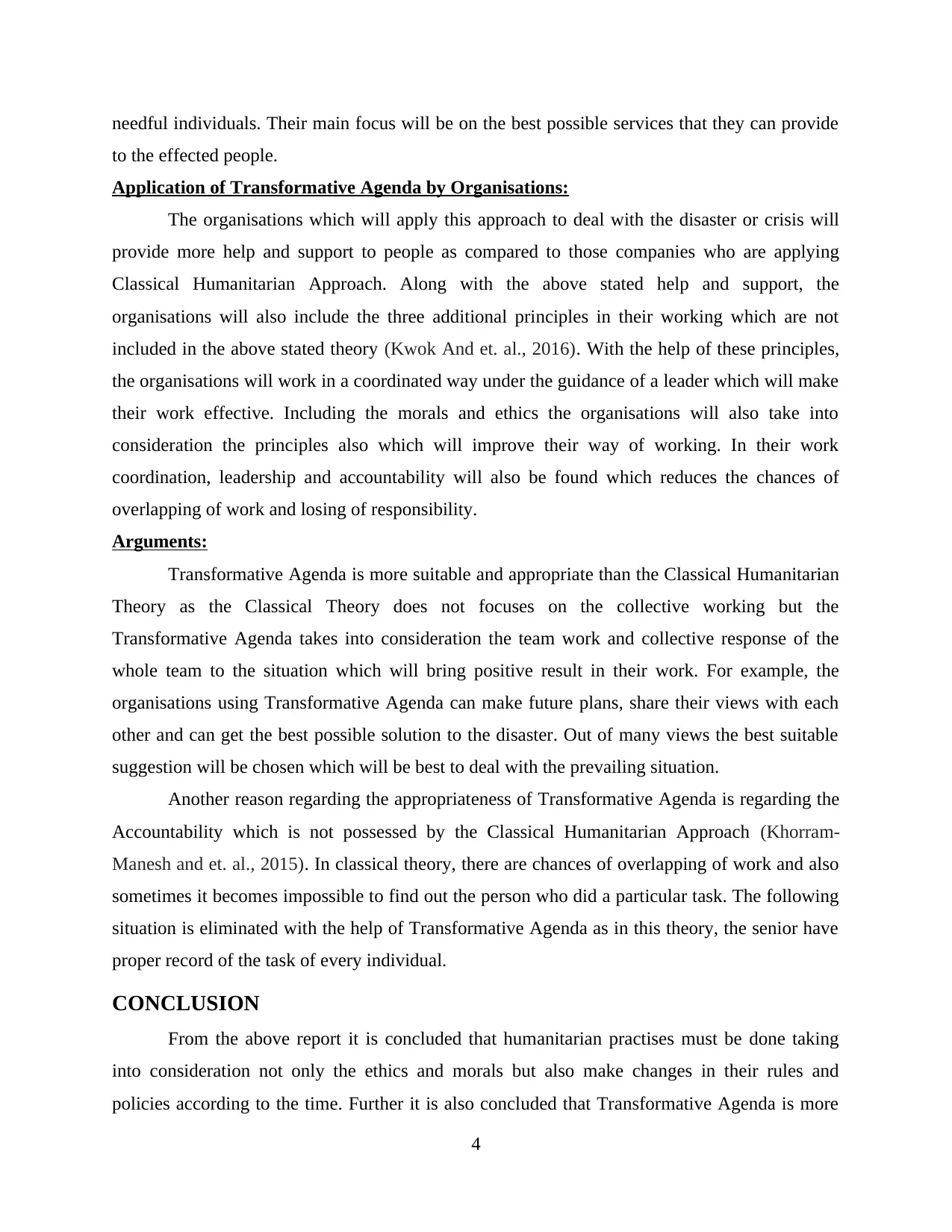
needful individuals. Their main focus will be on the best possible services that they can provide
to the effected people.
Application of Transformative Agenda by Organisations:
The organisations which will apply this approach to deal with the disaster or crisis will
provide more help and support to people as compared to those companies who are applying
Classical Humanitarian Approach. Along with the above stated help and support, the
organisations will also include the three additional principles in their working which are not
included in the above stated theory (Kwok And et. al., 2016). With the help of these principles,
the organisations will work in a coordinated way under the guidance of a leader which will make
their work effective. Including the morals and ethics the organisations will also take into
consideration the principles also which will improve their way of working. In their work
coordination, leadership and accountability will also be found which reduces the chances of
overlapping of work and losing of responsibility.
Arguments:
Transformative Agenda is more suitable and appropriate than the Classical Humanitarian
Theory as the Classical Theory does not focuses on the collective working but the
Transformative Agenda takes into consideration the team work and collective response of the
whole team to the situation which will bring positive result in their work. For example, the
organisations using Transformative Agenda can make future plans, share their views with each
other and can get the best possible solution to the disaster. Out of many views the best suitable
suggestion will be chosen which will be best to deal with the prevailing situation.
Another reason regarding the appropriateness of Transformative Agenda is regarding the
Accountability which is not possessed by the Classical Humanitarian Approach (Khorram-
Manesh and et. al., 2015). In classical theory, there are chances of overlapping of work and also
sometimes it becomes impossible to find out the person who did a particular task. The following
situation is eliminated with the help of Transformative Agenda as in this theory, the senior have
proper record of the task of every individual.
CONCLUSION
From the above report it is concluded that humanitarian practises must be done taking
into consideration not only the ethics and morals but also make changes in their rules and
policies according to the time. Further it is also concluded that Transformative Agenda is more
4
to the effected people.
Application of Transformative Agenda by Organisations:
The organisations which will apply this approach to deal with the disaster or crisis will
provide more help and support to people as compared to those companies who are applying
Classical Humanitarian Approach. Along with the above stated help and support, the
organisations will also include the three additional principles in their working which are not
included in the above stated theory (Kwok And et. al., 2016). With the help of these principles,
the organisations will work in a coordinated way under the guidance of a leader which will make
their work effective. Including the morals and ethics the organisations will also take into
consideration the principles also which will improve their way of working. In their work
coordination, leadership and accountability will also be found which reduces the chances of
overlapping of work and losing of responsibility.
Arguments:
Transformative Agenda is more suitable and appropriate than the Classical Humanitarian
Theory as the Classical Theory does not focuses on the collective working but the
Transformative Agenda takes into consideration the team work and collective response of the
whole team to the situation which will bring positive result in their work. For example, the
organisations using Transformative Agenda can make future plans, share their views with each
other and can get the best possible solution to the disaster. Out of many views the best suitable
suggestion will be chosen which will be best to deal with the prevailing situation.
Another reason regarding the appropriateness of Transformative Agenda is regarding the
Accountability which is not possessed by the Classical Humanitarian Approach (Khorram-
Manesh and et. al., 2015). In classical theory, there are chances of overlapping of work and also
sometimes it becomes impossible to find out the person who did a particular task. The following
situation is eliminated with the help of Transformative Agenda as in this theory, the senior have
proper record of the task of every individual.
CONCLUSION
From the above report it is concluded that humanitarian practises must be done taking
into consideration not only the ethics and morals but also make changes in their rules and
policies according to the time. Further it is also concluded that Transformative Agenda is more
4
⊘ This is a preview!⊘
Do you want full access?
Subscribe today to unlock all pages.

Trusted by 1+ million students worldwide
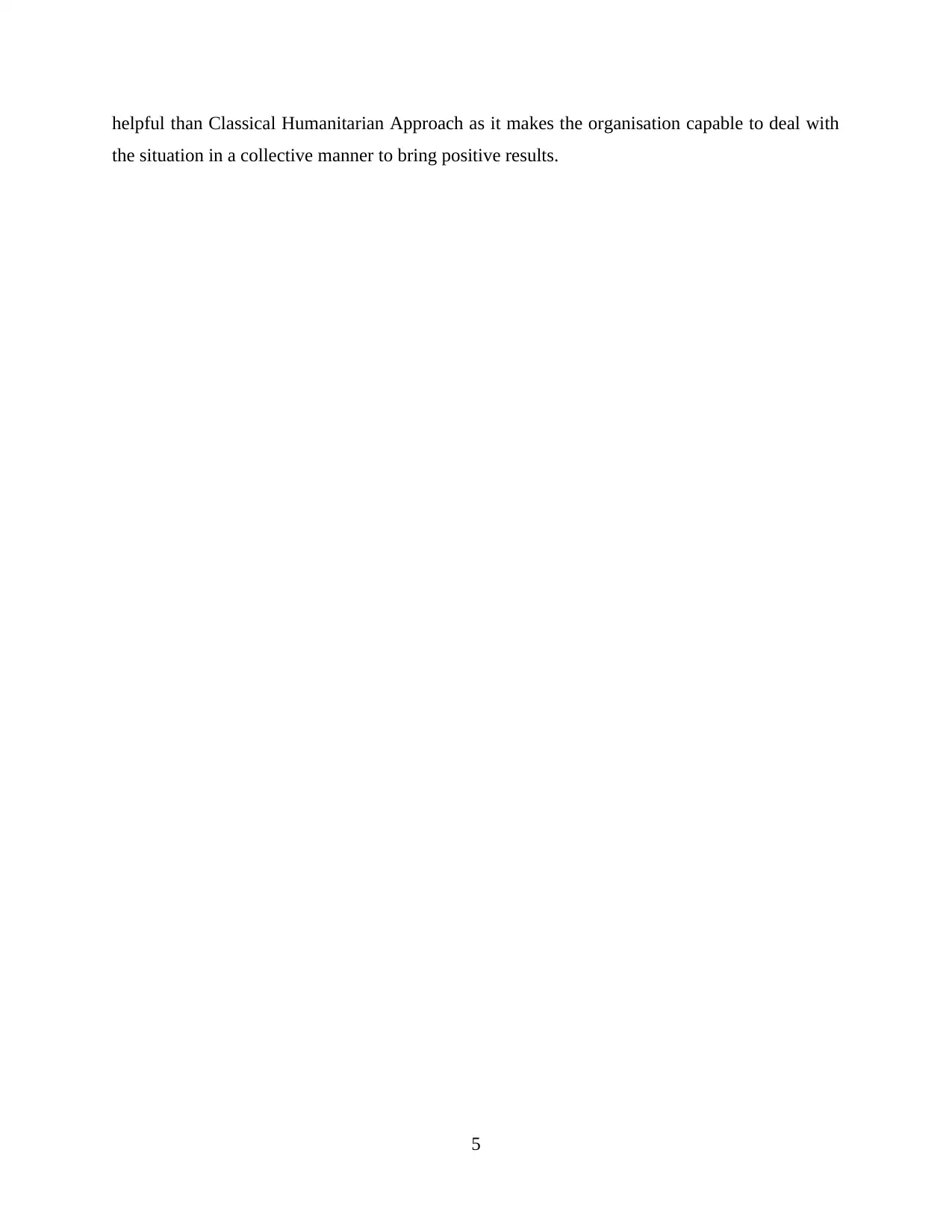
helpful than Classical Humanitarian Approach as it makes the organisation capable to deal with
the situation in a collective manner to bring positive results.
5
the situation in a collective manner to bring positive results.
5
Paraphrase This Document
Need a fresh take? Get an instant paraphrase of this document with our AI Paraphraser
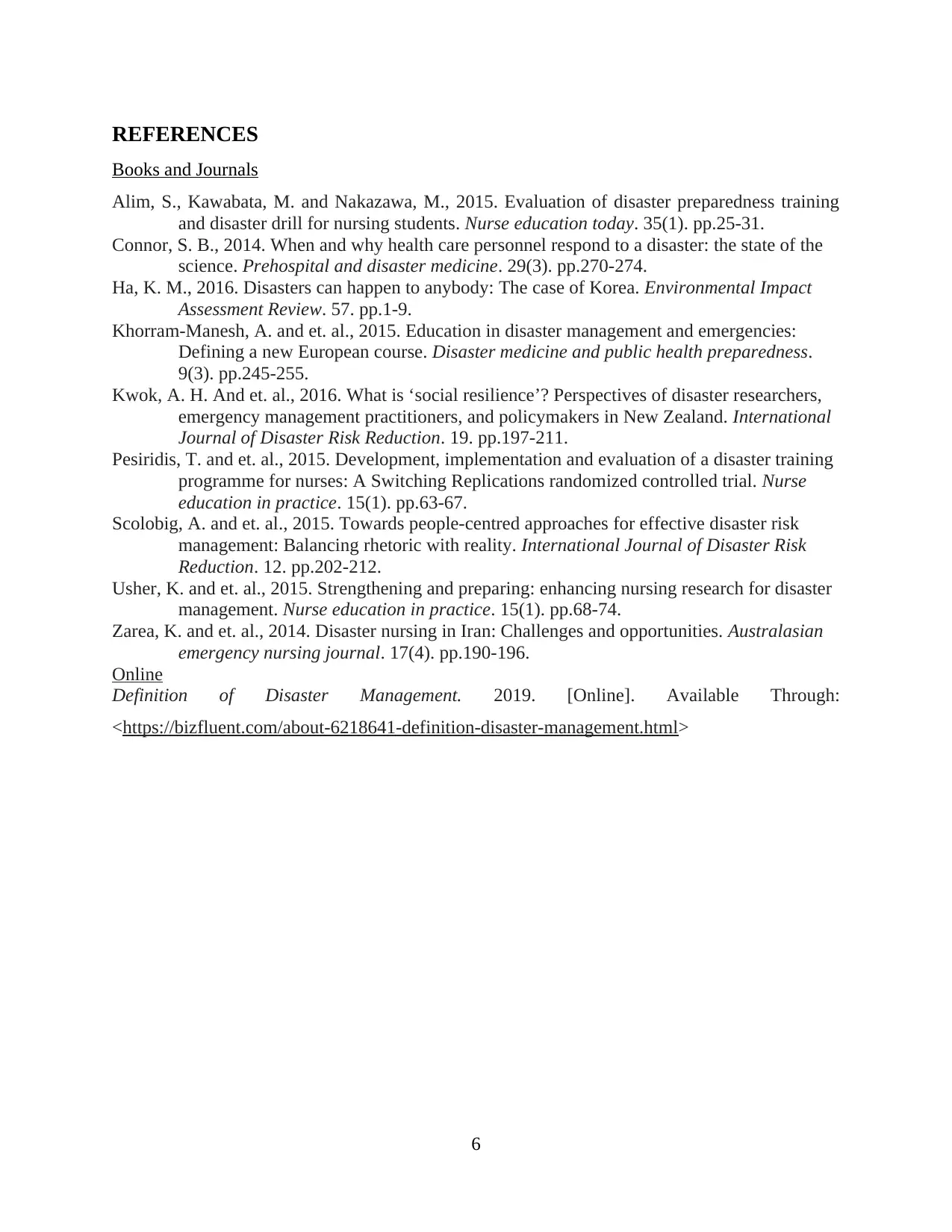
REFERENCES
Books and Journals
Alim, S., Kawabata, M. and Nakazawa, M., 2015. Evaluation of disaster preparedness training
and disaster drill for nursing students. Nurse education today. 35(1). pp.25-31.
Connor, S. B., 2014. When and why health care personnel respond to a disaster: the state of the
science. Prehospital and disaster medicine. 29(3). pp.270-274.
Ha, K. M., 2016. Disasters can happen to anybody: The case of Korea. Environmental Impact
Assessment Review. 57. pp.1-9.
Khorram-Manesh, A. and et. al., 2015. Education in disaster management and emergencies:
Defining a new European course. Disaster medicine and public health preparedness.
9(3). pp.245-255.
Kwok, A. H. And et. al., 2016. What is ‘social resilience’? Perspectives of disaster researchers,
emergency management practitioners, and policymakers in New Zealand. International
Journal of Disaster Risk Reduction. 19. pp.197-211.
Pesiridis, T. and et. al., 2015. Development, implementation and evaluation of a disaster training
programme for nurses: A Switching Replications randomized controlled trial. Nurse
education in practice. 15(1). pp.63-67.
Scolobig, A. and et. al., 2015. Towards people-centred approaches for effective disaster risk
management: Balancing rhetoric with reality. International Journal of Disaster Risk
Reduction. 12. pp.202-212.
Usher, K. and et. al., 2015. Strengthening and preparing: enhancing nursing research for disaster
management. Nurse education in practice. 15(1). pp.68-74.
Zarea, K. and et. al., 2014. Disaster nursing in Iran: Challenges and opportunities. Australasian
emergency nursing journal. 17(4). pp.190-196.
Online
Definition of Disaster Management. 2019. [Online]. Available Through:
<https://bizfluent.com/about-6218641-definition-disaster-management.html>
6
Books and Journals
Alim, S., Kawabata, M. and Nakazawa, M., 2015. Evaluation of disaster preparedness training
and disaster drill for nursing students. Nurse education today. 35(1). pp.25-31.
Connor, S. B., 2014. When and why health care personnel respond to a disaster: the state of the
science. Prehospital and disaster medicine. 29(3). pp.270-274.
Ha, K. M., 2016. Disasters can happen to anybody: The case of Korea. Environmental Impact
Assessment Review. 57. pp.1-9.
Khorram-Manesh, A. and et. al., 2015. Education in disaster management and emergencies:
Defining a new European course. Disaster medicine and public health preparedness.
9(3). pp.245-255.
Kwok, A. H. And et. al., 2016. What is ‘social resilience’? Perspectives of disaster researchers,
emergency management practitioners, and policymakers in New Zealand. International
Journal of Disaster Risk Reduction. 19. pp.197-211.
Pesiridis, T. and et. al., 2015. Development, implementation and evaluation of a disaster training
programme for nurses: A Switching Replications randomized controlled trial. Nurse
education in practice. 15(1). pp.63-67.
Scolobig, A. and et. al., 2015. Towards people-centred approaches for effective disaster risk
management: Balancing rhetoric with reality. International Journal of Disaster Risk
Reduction. 12. pp.202-212.
Usher, K. and et. al., 2015. Strengthening and preparing: enhancing nursing research for disaster
management. Nurse education in practice. 15(1). pp.68-74.
Zarea, K. and et. al., 2014. Disaster nursing in Iran: Challenges and opportunities. Australasian
emergency nursing journal. 17(4). pp.190-196.
Online
Definition of Disaster Management. 2019. [Online]. Available Through:
<https://bizfluent.com/about-6218641-definition-disaster-management.html>
6
1 out of 8
Related Documents
Your All-in-One AI-Powered Toolkit for Academic Success.
+13062052269
info@desklib.com
Available 24*7 on WhatsApp / Email
![[object Object]](/_next/static/media/star-bottom.7253800d.svg)
Unlock your academic potential
Copyright © 2020–2025 A2Z Services. All Rights Reserved. Developed and managed by ZUCOL.



